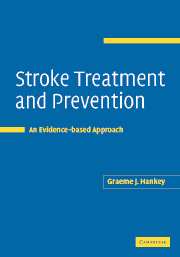Book contents
- Frontmatter
- Contents
- Preface
- 1 The size of the problem of stroke
- 2 Understanding evidence
- 3 Organised acute stroke care
- 4 General supportive acute stroke care
- 5 Reperfusion of ischaemic brain by thrombolysis
- 6 Augmentation of cerebral blood flow: fibrinogen-depleting agents, haemodilution and pentoxifylline
- 7 Neuroprotection
- 8 Treatment of brain oedema
- 9 Anticoagulation
- 10 Antiplatelet therapy
- 11 Carotid artery revascularisation
- 12 Lowering blood pressure
- 13 Lowering blood cholesterol concentrations
- 14 Modification of other vascular risk factors and lifestyle
- 15 Antithrombotic therapy for preventing recurrent cardiogenic embolism
- 16 Arterial dissection and arteritis
- 17 Treatment of intracerebral haemorrhage
- 18 Treatment of subarachnoid haemorrhage
- References
- Index
17 - Treatment of intracerebral haemorrhage
Published online by Cambridge University Press: 23 December 2009
- Frontmatter
- Contents
- Preface
- 1 The size of the problem of stroke
- 2 Understanding evidence
- 3 Organised acute stroke care
- 4 General supportive acute stroke care
- 5 Reperfusion of ischaemic brain by thrombolysis
- 6 Augmentation of cerebral blood flow: fibrinogen-depleting agents, haemodilution and pentoxifylline
- 7 Neuroprotection
- 8 Treatment of brain oedema
- 9 Anticoagulation
- 10 Antiplatelet therapy
- 11 Carotid artery revascularisation
- 12 Lowering blood pressure
- 13 Lowering blood cholesterol concentrations
- 14 Modification of other vascular risk factors and lifestyle
- 15 Antithrombotic therapy for preventing recurrent cardiogenic embolism
- 16 Arterial dissection and arteritis
- 17 Treatment of intracerebral haemorrhage
- 18 Treatment of subarachnoid haemorrhage
- References
- Index
Summary
Rupture of a blood vessel in the brain, resulting in intracerebral haemorrhage, causes immediate damage to neurones in the deep nuclei or cortex, and disruption of white matter tracts.
Direct mechanical compression of the brain tissue surrounding the haematoma and, to some extent, vasoconstrictor substances in extravasated blood, may compromise the local blood supply (Mendelow, 1993), and lead to cellular ischaemia which, in turn, leads to further swelling from cytotoxic, and later vasogenic, oedema. The zone of ischaemia around the haematoma may extend and swell through systemic factors such as hypoxia, hypotension and a loss of cerebral autoregulation in the vasculature supplying the region of the haematoma.
Haematomas adjacent to the ventricular system, such as cerebellar and large basal ganglia haematomas, may also directly compress the cerebrospinal fluid (CSF) pathway or rupture into the CSF pathway, and prevent outflow of the CSF from the brain, causing hydrocephalus (Ropper, 1986).
Due to the protective rigid encasement of the skull, the sudden increase in volume within the intracranial cavity due to the haemorrhage increases the intracranial pressure and threatens other parts of the brain, especially when the intracranial pressure reaches levels of the same order of magnitude as the arterial pressure, reducing the cerebral perfusion pressure close to zero.
About 25% of patients with intracerebral haematoma (ICH) die during the first day, and 40% within the first month, usually as a consequence of supratentorial haemorrhage large enough to cause transtentorial herniation, or haemorrhage in the posterior fossa causing direct brainstem compression and herniation upwards and downwards (Broderick et al., 1999).
- Type
- Chapter
- Information
- Stroke Treatment and PreventionAn Evidence-based Approach, pp. 360 - 375Publisher: Cambridge University PressPrint publication year: 2005



